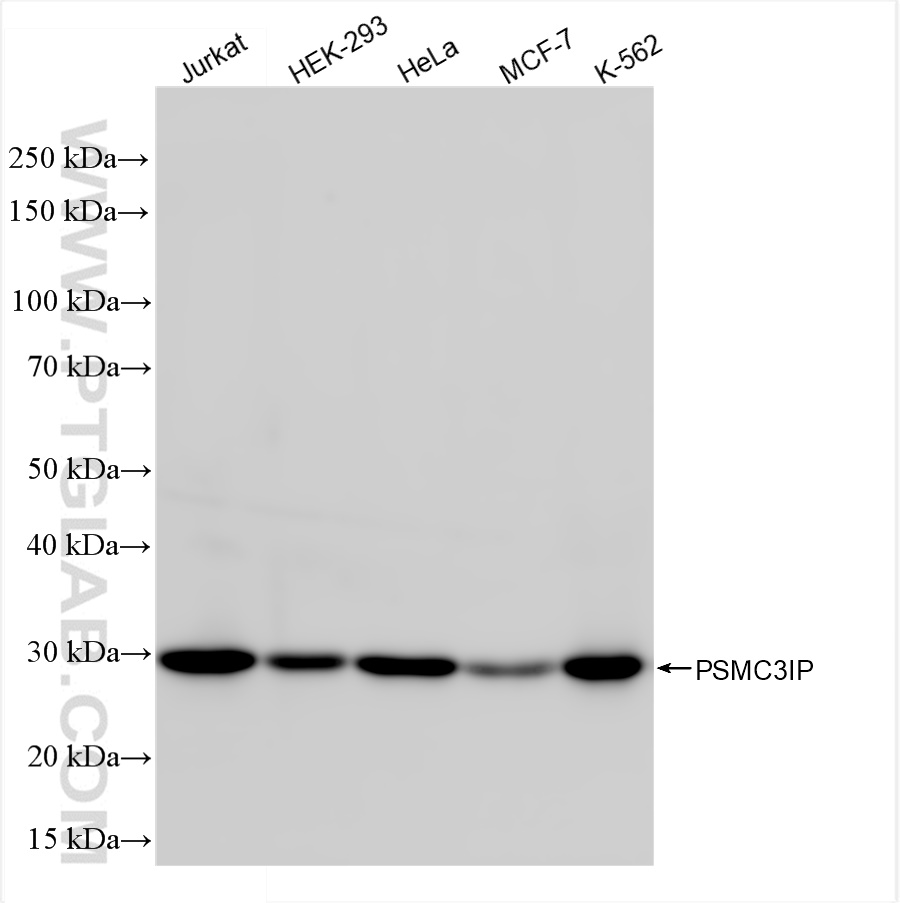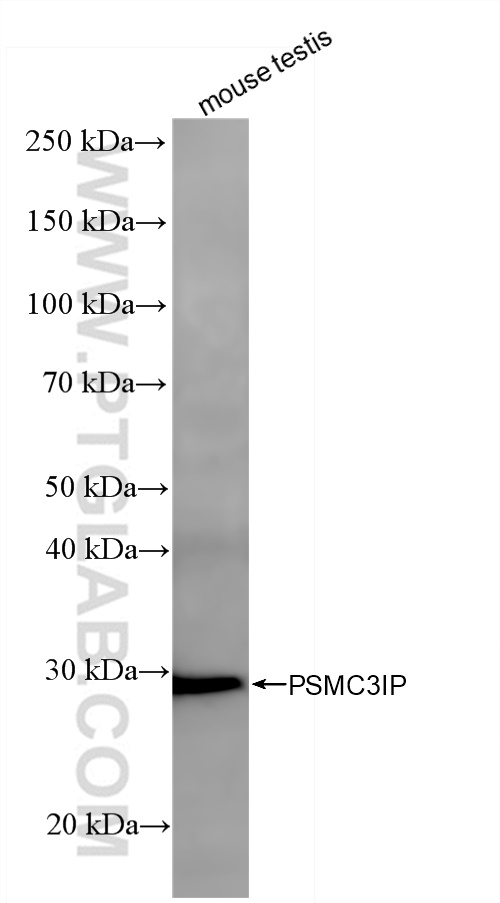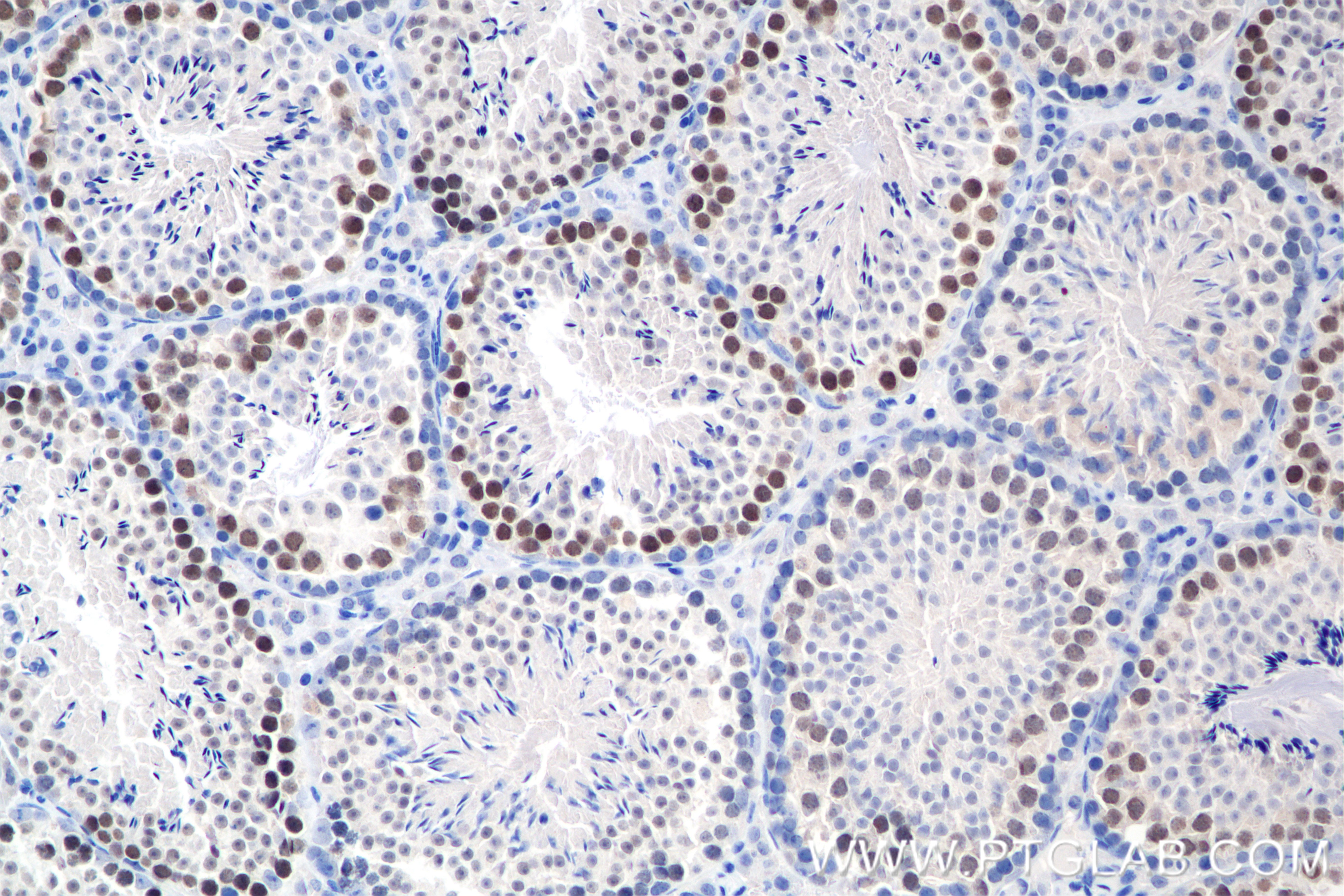验证数据展示
经过测试的应用
| Positive WB detected in | Jurkat cells, mouse testis tissue, HEK-293 cells, HeLa cells, MCF-7 cells, K-562 cells |
| Positive IHC detected in | mouse testis tissue Note: suggested antigen retrieval with TE buffer pH 9.0; (*) Alternatively, antigen retrieval may be performed with citrate buffer pH 6.0 |
推荐稀释比
| 应用 | 推荐稀释比 |
|---|---|
| Western Blot (WB) | WB : 1:1000-1:6000 |
| Immunohistochemistry (IHC) | IHC : 1:250-1:1000 |
| It is recommended that this reagent should be titrated in each testing system to obtain optimal results. | |
| Sample-dependent, Check data in validation data gallery. | |
产品信息
84934-1-RR targets PSMC3IP in WB, IHC, ELISA applications and shows reactivity with human, mouse samples.
| 经测试应用 | WB, IHC, ELISA Application Description |
| 经测试反应性 | human, mouse |
| 免疫原 |
CatNo: Ag1883 Product name: Recombinant human PSMC3IP protein Source: e coli.-derived, PGEX-4T Tag: GST Domain: 1-205 aa of BC008792 Sequence: MSKGRAEAAAGAAGILLRYLQEQNRPYSSQDVFGNLQREHGLGKAVVVKTLEQLAQQGKIKEKMYGKQKIYFADQDQFDMVSDADLQVLDGKIVALTAKVQSLQQSCRYMEAEMQKEIQELKKECAGYRERLKNIKAATNHVTPEEKEQVYRERQKYCKEWRKRKRMATELSDAILEGYPKSKKQFFEEVGIETDEDYNVTLPDP 种属同源性预测 |
| 宿主/亚型 | Rabbit / IgG |
| 抗体类别 | Recombinant |
| 产品类型 | Antibody |
| 全称 | PSMC3 interacting protein |
| 别名 | 242517C12, GT198, Homologous-pairing protein 2 homolog, HOP2, Proteasome 26S ATPase subunit 3-interacting protein |
| 计算分子量 | 25 kDa |
| 观测分子量 | 24-29 kDa |
| GenBank蛋白编号 | BC008792 |
| 基因名称 | PSMC3IP |
| Gene ID (NCBI) | 29893 |
| 偶联类型 | Unconjugated |
| 形式 | Liquid |
| 纯化方式 | Protein A purification |
| UNIPROT ID | Q9P2W1 |
| 储存缓冲液 | PBS with 0.02% sodium azide and 50% glycerol, pH 7.3. |
| 储存条件 | Store at -20°C. Stable for one year after shipment. Aliquoting is unnecessary for -20oC storage. |
背景介绍
PSMC3IP, also called HOP2, encodes a protein that functions in meiotic recombination. It is a subunit of the PSMC3IP/MND1 complex, which interacts with PSMC3/TBP1 to stimulate DMC1- and RAD51-mediated strand exchange during meiosis. The protein encoded by this gene can also co-activate ligand-driven transcription mediated by estrogen, androgen, glucocorticoid, progesterone, and thyroid nuclear receptors. Mutations in this gene cause XX female gonadal dysgenesis.
实验方案
| Product Specific Protocols | |
|---|---|
| IHC protocol for PSMC3IP antibody 84934-1-RR | Download protocol |
| WB protocol for PSMC3IP antibody 84934-1-RR | Download protocol |
| Standard Protocols | |
|---|---|
| Click here to view our Standard Protocols |




